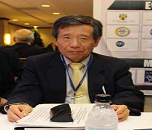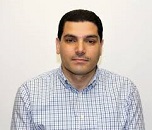Day 2 :
Keynote Forum
Masaru Matsuo
Dalian University of Technology, China
Keynote: Dynamic tensile modulus of positive temperature coefficient materials under electric field investigated in terms of low frequency earthquake counter measures

Biography:
Masaru Matsuo has completed his PhD from Kyoto University in Japan and was a Professor of Nara Women’s University. After his retirement, he became a full time Professor of Dalian University of Technology in China. Since September 1st 2014, he is a Visiting Professor of Dalian University of Technology. He has published more than 200 papers in refereed journal articles. He is IUPAC fellow and received Certificate of Membership Award of ACS (July 2015~July 2018). He received “The Award of the Society of Fiber Science and Technology of Japan” in May 1990, “Paul Flory Polymer Research Prize” in April 2010 and “Certificate of Friendship Award of Liaoning Province in China” in September 2011.
Abstract:
PTC materials play important roles in promoting significant applications to floor heating and loft heating in order to get rid of snow removing by humans. To assure comfortable daily living in winter, the cost effective floor heating and loft heating must be established. Obviously, light PTC materials as heating elements have advantages for saving construction cost of building circulation rather than heavy hot water tubes in addition to the safety and cleanliness. Recently, PTC materials for floor heating and loft heating tend to be adopted on designing rooms in an apartment building. However, when earthquake with low frequency generate in winter, the residents must consider the serious damages. Certainly, since the serious damage of bank building by low frequency earthquake (0.1~2 Hz) at Mexico in 1985, the horrors of low-frequency earthquake have been investigated in terms to predominant period of ground and natural frequency of the construction materials relating to building height. Accordingly, the serious damages of recent buildings tend to decrease by the new design methods for preventing collapse of constructions. Different from such earthquake counter measures, however, there is no report on the damage of PTC materials against low-frequency earthquake, since no experimental method has been established for the frequency dependence of mechanical properties under applied electric fields. This presentation is focused on frequency dependence of the complex dynamic tensile modulus of PTC materials under applied electric field. Fine home-made attachments were fixed on a commercial visco-elastic spectrometer to measure the modulus with different frequencies at the desired temperatures. Efforts were done to determine static strain in order to place the sample in tension during axial sinusoidal oscillation. The measurements were carried out for ultra-high molecular weight polyethylene (UHMWPE)-nickel (Ni) coated carbon fiber (NiCF) composites which have been adopted as PTC materials. The drastic descent of the storage modulus was confirmed in lower frequency range (0.01~2 Hz) at surface temperature (Ts) elevated by Joule heat. That is, storage modulus by self-heating is much lower than that by external heating at the same temperature. This tendency became considerable beyond 65°C. The
composite was cut when Ts was beyond 93°C. In contrast, the cutting did not occur in higher frequency range (100~10 Hz) at Ts=105°C. The present fundamental work warns that protection of PTC materials used as floor heating must be taken into consideration in terms of low frequency earthquake in addition of the seismic intensity.
Keynote Forum
Alain Demourgues
University of Bordeaux, France
Keynote: The world of fluorine-based nano-materials: Past, present and future

Biography:
A Demourgues is working at ICMCB-CNRS-UPR9048 since October 1993 as Research Fellow. He became Research Director at CNRS in October 2008. He received IBM-France award in 1993 (Young Scientist in Materials Science) and SFC (Société Française de Chimie) award in 2003 (Solid State Chemistry division). He is Consulting Scientist since 1998 at RHODIA-SOLVAY in the field of Solid State Chemistry, Redox and Opto-electronic properties.
Abstract:
The aim of this presentation is to illustrate, considering various new ‘nano’ oxy(hydroxyl)fluorides prepared by hydrothermal routes, the key role of cationic/anionic vacancies allow relaxing the structure (bond distances and angles) which explain outstanding physical-chemical properties (reactivity, UV-Vis-NIR absorption and electrochemistry). Nanoparticles of crystallized phases have been obtained by microwave assisted solvothermal routes using HF, various solvents and precursors
leading to control the composition, the crystal structure, the nanosize particles and the surface area. The case of Ti-based oxy(hydroxy)fluorides with Ti vacancies and unexpected UV shielding properties with band gap around 3.2eV and small refractive index around 1.9 will be presented. Al fluoride hydrate also with cationic vacancies, structural water and fluorine as ligands of Al3+ ions, has been synthesized and exhibits Lewis-Brönsted acidities. The strong acidic behavior highlights
the effect of water molecules/cationic vacancies on the surface structure. Both these compounds adopt also derived ReO3 frameworks. Ti vacancies can be also stabilized in derived Hexagonal Tungsten Bronzes (HTB) and anatase form containing O2-, OH- and F- species but the cationic vacancies rate remains smaller in these last cases than in the previous ReO3 form. The more complex case of trivalent Fe-based oxyfluorides will be presented by outlining the occurrence of cationic and anionic
vacancies in this network where these compounds adopt the HTB used as cathodes in Li-ion battery. Finally, nanoparticles of tetravalent Ce-based oxyfluorides with fluorite-type structure where anions are in tetrahedral sites, have been prepared by co-precipitation in basic (pH=12) medium. The presence of Ca2+ partially substituted for Ce4+ and F- for O2- allows tuning the optical band gap at the UV-Visible frontier and obtaining new UV absorbers with low refractive index. The role played by fluorine substituting for O2-/OH- ions will be highlighted which allows creating cationic and anionic vacancies in these nanomaterials and contributes to tune the optical absorption properties as well as the acidic and redox properties.
Keynote Forum
Edward Yi Chang
National Chiao Tung University, Taiwan
Keynote: Nano scale InGaAs FinFET for post Si CMOS application
Time : 10:00-10:30

Biography:
Edward Yi Chang has received the PhD degree from University of Minnesota, Minneapolis, in 1985. In 1992, he joined National Chiao Tung University (NCTU), Hsinchu, Taiwan. He is currently a Senior Vice President of National Chiao Tung University, Dean of Research and Development of NCTU, Dean of International Semiconductor School and Chair Professor of the Department of Materials Science and Engineering and Department of Electronics Engineering. He is an IEEE Fellow and a Distinguished Lecturer of the IEEE Electron Devices Society. His current research interests include III-V compounds based devices for power, electrical and optical applications. He holds more than 30 patents worldwide and has been author or co-author of more than 120 papers in the related research areas.
Abstract:
To meet Moore’s law, the academia and industry have worked rigorously to develop advanced technologies in order to reach the ITRS roadmap standard. However, as the devices are reaching their physical limits, we are facing challenges; two most effectively ways to keep the device scaling are either using different transistor architectures or using advanced high mobility channels. Among many III-V compound semiconductors, InxGa1-xAs materials are the most promising candidates as high electron mobility channels for scaling CMOS devices to satisfy the quest of future logic applications. Besides, high-k materials, owning to its high permittivity is very critical material for integrating with III-V semiconductors in sub-nanometer technology regions. Unfortunately, inherently poor quality of high-k/III-V interfaces, which degrades the gate controllability and the channel mobility, has not been overcome yet. To achieve high efficiency and low power consumption high-k/III-V MOS devices, the MOS structures should have high interface quality in conjunction with a suitable and reliable dielectric gate stack. In addition, the gate metals must have effective work functions aligned with the band edges of the channel materials, as well as a small work function variation. This talk focuses on the metal/high-k/InGaAs interface study and several new results of the InGaAs FinFETs will be presented which can be the key technologies for next generation InGaAs channel based CMOS
technology.
Keynote Forum
Mohammad I Younis
King Abdullah University of Science and Technology, Saudi Arabia
Keynote: Nanoelectromechanical resonators for logic operations

Biography:
Mohammad I Younis received his PhD degree in Engineering Mechanics from Virginia Polytechnic Institute and State University in 2004. Since 2004, he has been serving as an Assistant and then as an Associate Professor of Mechanical Engineering at the State University of New York (SUNY), Binghamton, NY, USA. Currently, he is an Associate Professor of Mechanical Engineering at King Abdullah University of Science and Technology, Saudi Arabia, where he has served as a Director of the MEMS and NEMS Characterization and Motion Laboratory. He is a recipient of the SUNY Chancellor’s Award for Excellence in Scholarship and Creative Activities in 2012, the National Science Foundation Faculty Early Career Development Award in 2009, and the Paul E Torgersen Graduate Research Excellence Award in 2002. He serves as an Associate Editor of Nonlinear Dynamics, the Journal of Computational and Nonlinear Dynamics, and the Journal of Vibration and Control.
Abstract:
There has been remarkable interest in nanomechanical computing elements, which can potentially lead to a new era in computation due to their re-configurability, high integration density, and high switching speed. The last decade has witnessed increasing research interest in mechanical computing for scalable mechanical computing elements. This has been primarily driven by the need to overcome the higher leakage current and power dissipation of the transistor technology, which have become pronounced as the technology is reaching its physical limit. Downscaling MEMS devices into the nano regime offers exciting opportunities for realizing devices of ultralow power consumption, high sensitivity, and high integration density. The ongoing progress in nanofabrication technologies has enabled exploration of nanoelectromechanical systems (NEMS) for mechanical computing for memory and logic gate devices. In this work, we present an in-plane nanomechanical beam resonator, operated in its linear regime, capable of dynamically performing NOR, NOT, XNOR, XOR, and AND logic operations. The stiffness of the nano-beam and hence its resonance frequency is modulated electro- thermally with two DC voltage sources representing the logic inputs. We also present for the first time an in-depth investigation into the performance of such electromechanical resonators under the effect of frequency fluctuations with temperature variation. The performance
of this re-configurable logic device is examined at elevated temperatures, ranging from 25°C to 85°C, demonstrating its resilience for most of the logic operations. The proposed device can potentially achieve switching rate in μ sec, switching energy in nJ, and an integration density up to 106 per cm2. The practical realization of this re-configurable device paves the way for nano-elements-based mechanical computing.
